![]()
![]()
![]()
Use LEFT and RIGHT arrow keys to navigate between flashcards;
Use UP and DOWN arrow keys to flip the card;
H to show hint;
A reads text to speech;
17 Cards in this Set
- Front
- Back
|
What are antigens?
|
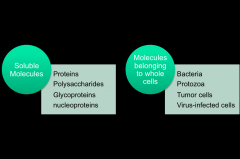
Molecules that are recognized and responded to by cells of the immune system.
|
|
|
What are epitopes:
|
The cells of the adaptive immune system react to small molecular domains of the antigen known as antigenic determinants, or epitopes.
|
|
|
Differences b/t B and T cells in terms of recognition:
|
-B cells can recognize an antigen by itself, whereas a T cell will only recognize an antigen if it is properly presented by an APC.
-T cells recognize only PROTEIN antigens!!!! -And they must be Processed & Presented by APCs. |
|
|
Describe the process of antigen presentation:
|
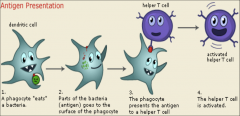
-APCs are very efficient at internalizing antigen by phagocytosis or by receptor-mediated endocytosis.
-The antigen is then “processed” internally, and ultimately fragments of the antigen are displayed on the surface of APCs in conjunction with a complex called the MHC (major histocompatibility complex). -T cells recognize the Antigen-MHC complex using their TCRs. |
|
|
How are T cells grouped functionally?
|
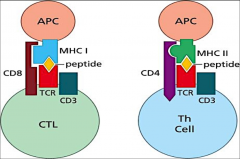
T cells are grouped functionally according to the class of MHC molecules that associate with the peptide fragments of the protein.
CD8-MHC I CD4-MHC II |
|
|
Where do APCs and T cells meet?
|
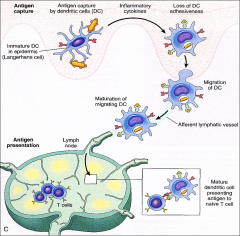
In the secondary lymphoid organs!
("conference centers") |
|
|
MHC molecules:
|
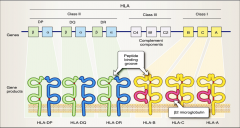
MHC (or HLA in humans) is a complex of genes that encodes several proteins known as class I and class II MHC molecules.
|
|
|
∆ Between MHC I and II ?
|

MHC I is expressed on all nucleated cells. Associated with CD8.
MHC II only expressed by APCs. Associated with CD4. |
|
|
Why is it important that we have both MHC I and II molecules?
|
-All nucleated cells express MHC I. This focuses T cell attention on ONLY cells that are infected (and therefore presenting antigen of) by pathogens.
-Makes sure T cells don't waste time doing the work that antibodies are already doing. -Ensures both the APC and the T cell agree that there's a problem. -Separation of the class I and class II pathways of antigen processing, establishes T cell effector responses required for elimination of extracellular or intracellular microbes. |
|
|
How is diversity of MHC molecules promoted? 2
|
-Co-dominant expression; both parental alleles of each MHC gene are expressed.
-MHC genes are very polymorphic; many different alleles are present in the population. |
|
|
Describe the structure of MHC class I and II proteins:
|
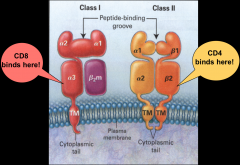
I: single structure; the binding domains and a transmembrane domain. Associates with a protein called ß2m. Peptide-binding groove is between alpha1 and alpha2 domains. CD8 binds to alpha3 domain.
II: 2 transmembrane chains with alpha and ß domains. Peptide binding groove is b/t alpha1 and ß1 domains. Binds larger AAs than MHC I can. CD4 binds to ß2 domain. |
|
|
Describe the peptide binding grooves in MHC I and II:
|
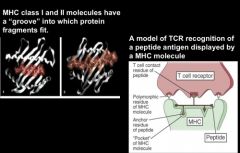
MHC I holds small AA sequences and is 'closed.'
MHC II holds larger AA sequences and is open, like a hotdog overlapping a bun. |
|
|
Key points about Class I MHCs: 3
|
Class I MHC molecules are found on all nucleated cells.
Class I MHC molecules load intracellular peptides. Class I MHC + peptides are recognized by CTLs (Cytotoxic T lymphocytes). |
|
|
Describe the process of antigen presentation onto MHC I molecules:
|

*TAP gets proteins to the ER. MHC is first associated with peptide at the level of the ER.
|
|
|
Key points about Class II MHCs: 3
|
Class II MHC molecules are found on APCs.
Class II MHC molecules load extracellular peptides. Class II MHC + peptides are recognized by CD4 (T helper) cells. |
|
|
Describe the process of antigen presentation onto MHC II molecules:
|
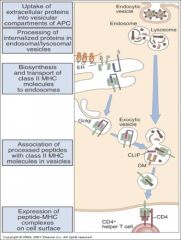
-peptides are EXTRAcellular; process is intracellular
-endosome -lysosome -invariant chain facilitates export of class II MHC from the ER -DM removes CLIP to open binding region. |
|
|
Infection is defined as:
|
Attachment and entry of a pathogen into the host.
|

